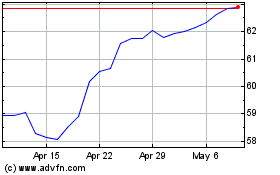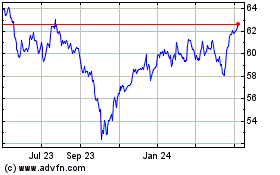After struggling for years to turn around sluggish sales, Sam's
Club is now pursuing a more fundamental fix: breaking away from the
low-income consumers who shop at at its parent, Wal-Mart Stores
Inc.
"We want to be less of a Wal-Mart," said Rosalind Brewer, chief
executive of the warehouse-club retailer that has tried more modest
moves like improving online ordering and adding such services as
tax preparation that appeal to small-business members.
The new strategy means carrying fewer products that appeal to
households that earn $45,000 a year—Wal-Mart's sweet spot—in favor
of targeting wealthier shoppers with more organic food, brand-name
clothes and 1,000-thread count Egyptian cotton sheets, she said
during a recent interview.
Sam's struggle to shake an early focus on mainstream consumers
has become a liability as club stores have evolved into a favorite
among more affluent shoppers who are able to pay a membership fee
for access to discounts on items from large screen TVs to bulk
boxes of peaches. At the same time, big- box retailers and grocery
stores have embraced discounted bulk sizes, without a membership
fee. Rival Costco Wholesale Corp. has thrived, building stores in
wealthy enclaves and delivering strong annual sales gains.
For Sam's part of the challenge is Wal-Mart itself. Wal-Mart
founder Sam Walton created the warehouse chain in 1983 as a place
for small businesses to stock up on discounted bulk items, not as a
Wal-Mart clone that offers everyone everyday deals. But as Wal-Mart
grew, Sam's followed. Now, some 200 of Sam's about 650 U.S. stores
share a parking lot with a Wal-Mart.
"By far, and regardless of region, Wal-Mart is Sam's largest
competitor," says Sara Al-Tukhaim, a director at Kantar Retail, a
consulting and research firm. Kantar data shows that 81% of Sam's
shoppers say they also shopped at Wal-Mart in the past four weeks,
compared with a 15% overlap with Costco, says Ms. Al-Tukhaim.
Twenty percent of Wal-Mart shoppers say they also went to Sam's
Club, she says.
Ms. Brewer doesn't agree that Wal-Mart is her biggest competitor
but she notes that "a winning model is when Wal-Mart operates in
their lane and Sam's in their lane." Most of Sam's products are
already different than Wal-Mart's, but when Sam's sells single
deodorants or Wal-Mart sells five pound bags of frozen
strawberries, the two stores are competing, said Ms. Brewer, who
has been CEO since 2012.
Growth in Sam's club stores open at least a year inched up 0.5%
in its last fiscal year, a gain dwarfed by Costco's 6% increase
over a similar period. For the past five years, Sam's has lagged
behind Costco's growth. Total sales at Sam's hit $58 billion last
year while Costco booked $110 billion from its 664 global stores.
Sam's accounts for about 12% of Wal-Mart's $482 billion in annual
revenue.
Costco has done well in part because it clusters stores around
urban areas and along the country's coasts, drawing a wealthier
clientele that has fared well in the economic recovery. It went
into organic foods early and now offers an average of about 200
organic items per store. Sales of organic food at Costco are about
$4 billion a year, said Richard Galanti, chief financial officer
for Costco, the third largest retailer in the U.S. by revenue.
Mr. Galanti sees Sam's as Costco's most direct competitor, but
he notes that Costco's strength is its laser focus on club stores,
while Sam's is but one of several priorities for Wal-Mart. Costco
also has regional product buyers who can hone purchases to local
preferences. Sam's buyers are all based in Bentonville, Ark.,
Wal-Mart's home.
Sam's has made forays into more premium products like those at
Costco, but frequent leadership changes have stymied efforts to
shake its parent's influence. In 2001, Sam's added expensive
jewelry and said it wanted to sell high-end art to better compete
with Costco. Those plans floundered however when Sam's president
left in 2002. More recently Ms. Brewer's predecessor, Brian
Cornell, added more fresh food and upgraded merchandise. Mr.
Cornell is now CEO of Target Corp.
Running Sam's Club has been a steppingstone to larger jobs at
the parent company. Wal-Mart's current CEO, Doug McMillon, managed
Sam's from 2006 to 2009. Eight executives have run Sam's in the
last 20 years.
Sam's executives are starting to use new technology to study its
consumers, gaining access to data on the specific demographics of
shoppers at each club, including household income by ZIP Code of
shoppers, said Bill Durling, a spokesman for Sam's. That data
showed that 150 Sam's are located in areas with many high-income
shoppers but don't draw enough of those customers.
In two regions, the retailer is testing what a high-end Sam's
might look like, with more individual prepared meals, pricey
furniture, apparel and food alongside rows of bulk Coca-Cola
typical in most Sam's Clubs. The test allows a small team of Sam's
buyers to practice selecting products with wealthy consumers in
mind. The aim is to try to attract shoppers that might also shop at
places like Whole Foods Market Inc.
However, many of Sam's top suppliers don't sell products that
target wealthier shoppers, making the transition more
difficult.
Last fall Sam's buyers called Maple Hill Creamery hoping to sell
its organic yogurt made in New York. "I was absolutely surprised,"
said Tim Joseph, founder of the company.
After the first call Mr. Joseph said he went to his local Sam's
store in Albany, N.Y., and found no organic foods selection. He
rejected Sam's buyers' overtures three times, worried his tart,
full fat, lightly sweetened yogurt wouldn't be a hit with its
customers.
Eventually he was lured to Bentonville, Ark., for a tour of the
flagship store where Sam's buyers explained they are working to add
more premium and organic food, he said. Maple Hill Creamery yogurt
now is being sold in about 150 Sam's Clubs mainly in Michigan,
Texas and the Northeast, but sales haven't met expectations yet,
said Mr. Joseph.
"They are being patient," he said.
Write to Sarah Nassauer at sarah.nassauer@wsj.com
Subscribe to WSJ: http://online.wsj.com?mod=djnwires
(END) Dow Jones Newswires
August 17, 2015 08:15 ET (12:15 GMT)
Copyright (c) 2015 Dow Jones & Company, Inc.
Coca Cola (NYSE:KO)
Historical Stock Chart
From Mar 2024 to Apr 2024

Coca Cola (NYSE:KO)
Historical Stock Chart
From Apr 2023 to Apr 2024
